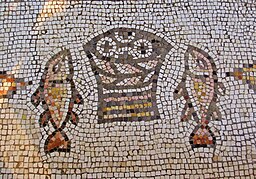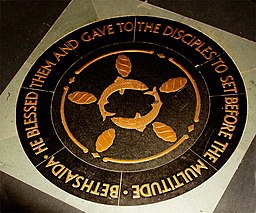Swamps
20th Sunday of the Year B (19 Aug 2012)
Homily of Fr. Paul Panaretos, S.J.
When I was a boy neighbors across the street were Mormon. They wondered aloud to my parents what use was going to church. Mom and Dad mentioned their question to me.They wanted me to learn early that people were different and that variety of belief colored our society. My young mind knew that because most of my Greek cousins are Greek Orthodox. Learning our neighbors’ question helped me appreciate less how we differ from others and more that we are a sacramental church. Sacraments use familiar things—water, oil, fire, bread, wine, words, touch—to remind us of the Trinity’s relationship with us and help us deepen our relationship. We worship together to help us all grow in it.
Sacraments are more than signs. Sacraments are not signs because signs have one meaning. Take an eight-sided red sign. It means stop and only stop. So clear and fixed is that that stop signs are not only on streets. Their images appear on web pages and on directions packaged with equipment. Sacraments are richer than signs. They offer more.
Sacraments offer more than single meanings: dying and rising (baptism); sacrifice and meal (eucharist); healing by sharing in Jesus’ cross (anointing the sick); two people making one life with both their personalities (marriage). Yet, those combinations don’t exhaust the meanings of sacraments. Sacraments are richer than signs. They are “swamps of meaning and swamps of being,” as my teacher vividly expressed it.1
Sacraments also make real and present what they express through their swamps of meaning. They have their hazardous sides: we enter swamps at our own risk. Jesus invites us to live differently, always a risk. All the while Jesus promises to stand beside us as we stand against whatever oppresses, whatever mocks life or harms people and whatever defies God’s justice and wisdom. As swamps of being, sacraments soak us in genuine life, divine life. Jesus announced with authority that he was both that life and the giver of his life to all.
Jesus expressed that with scripture familiar to his contemporaries and befitted his feeding them: God saved their ancestors and nourished them with manna.2 Bread from heaven it was, yet manna nourished the body. Jesus is the living bread which came down from heaven; whoever eats this bread will live forever and the bread that I will give is my flesh for the life of the world.
Jesus is true food and true drink by which we abide in Jesus and Jesus in us. But does not a person always enjoy Jesus’ presence within one’s heart? So our Mormon neighbors questioned my parents. Of course we do! Our eating and drinking at the Lord’s table is always a communal feast: first with our ears and eyes during the liturgy of the word; then by each one’s personal communion during the liturgy of the eucharist. Our eating and drinking at his table help us intensify the relationship Jesus already has with us.
To feast on our Messiah’s body and blood saturates us with Jesus’ Spirit and connects us with what is genuine, godly and wise. Many other things intoxicate us with the folly of the world, leading us to debauchery, to use St. Paul’s word. Debauchery is riotous living keeping us from our relationship with Jesus. Debauchery, too, results in killing—human spirits as well as human beings. Debauchery is also—this is so subtle to notice readily—a killing pace, against which all of us, adult and child, student and worker, spouses and friends and ordained ministers need to guard.3 Our greatest guardians are Jesus and deepening our relationship with him. Jesus’ body and blood is a key help to remain filled with [his] Spirit and not intoxicated by other things.
After communion we pause to pray privately.4 Our words, or the words of another we make ours, help us taste and savor the One we have eaten and drunk to become the One we have received, as St. Augustine taught his parishioners.5
In your daily 15 minutes with Jesus this week,
- Quiet yourself in the Trinity.
- Ask Lady Wisdom and the saints to present you to Jesus.
- Chat with Jesus about what you notice Jesus is doing in you and for you by his communion with you.
- Thank Jesus and ask him for the grace to live more intently as his friend and disciple and to live in a more friendly way with others and the entire earth. Don’t be surprised if Jesus challenges you. Do remember Jesus graces us to live his challenge.
- Close saying slowly the Lord’s Prayer. Our daily bread is Jesus and his Spirit; it also is our way of living.
Link to this homily’s Spiritual Exercise
_____________
- I first heard Fr. Aidan Kavanagh, O.S.B, say that in class in 1980. No doubt he used it in his lectures and published work
- John 6.48-50, immediately before today’s gospel.
- Nearly six years ago to the day, Pope Benedict quoted St. Bernard of Clarivaux during in his midday Angelus address. The saint addressed his former disciple, Pope Eugene III. "The dominant theme of [his message], extremely personal, is the importance of interior recollection—and he said this to a Pope—an essential element of piety. ¶This admonition is valid for all kinds of occupations, including those inherent to the governance of the Church. The message that, in this connection, Bernard addresses to the Pontiff, who had been his disciple at Clairvaux, is provocative: “See where these accursed occupations can lead you, if you continue to lose yourself in them—without leaving anything of yourself for yourself”
- General Instruction to the Roman Missal, 88.
- Augustine’s conviction of divine indwelling his Confessions make clear: “Why, then, do I ask thee to come into me, since I also am and could not be if thou wert not in me?” (I.2.2). His eucharistic teaching elaborates on the sacrament’s effects on us. In Sermon 57.7 Augustine taught Christians “are what they receive.” Also, Sermon 272 is often cited. Another line of his Confessions is telling: “You do not make Me into yourself, like the food of your flesh into you, you become Me!”—my paraphrase of Book 7, ch. 10.
________________________________________________________________
Wiki-image of the Tabgha mosaic was released into the public domain. Wiki-image by Jim Wroten of the Bethsaida medallion is used by CC BY-SA 3.0.


No comments:
Post a Comment